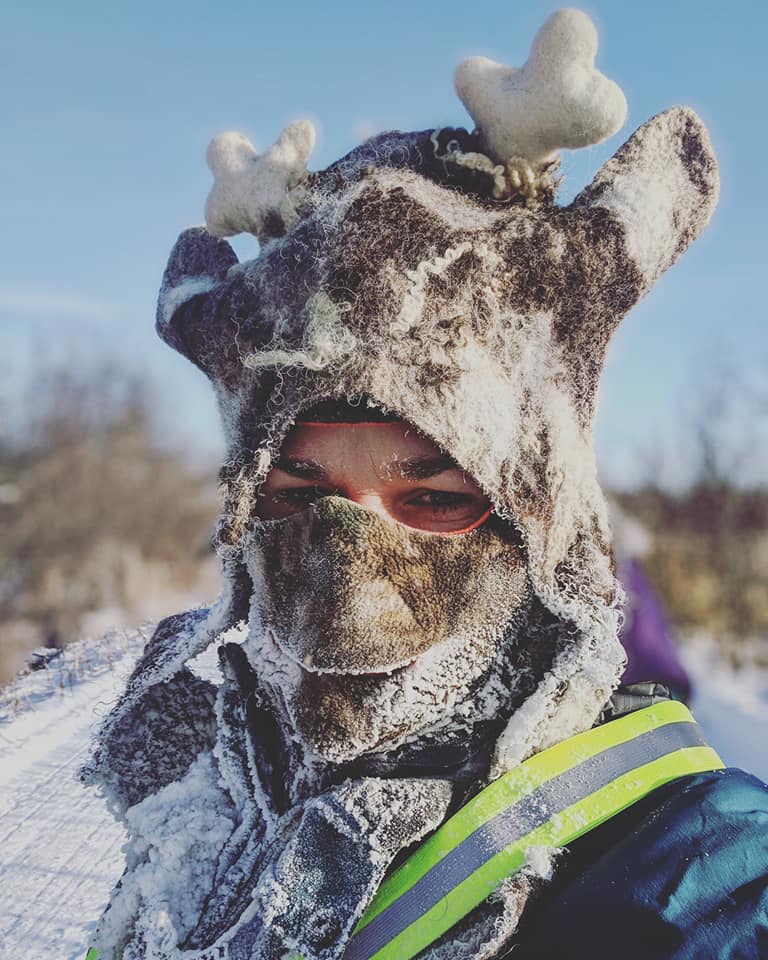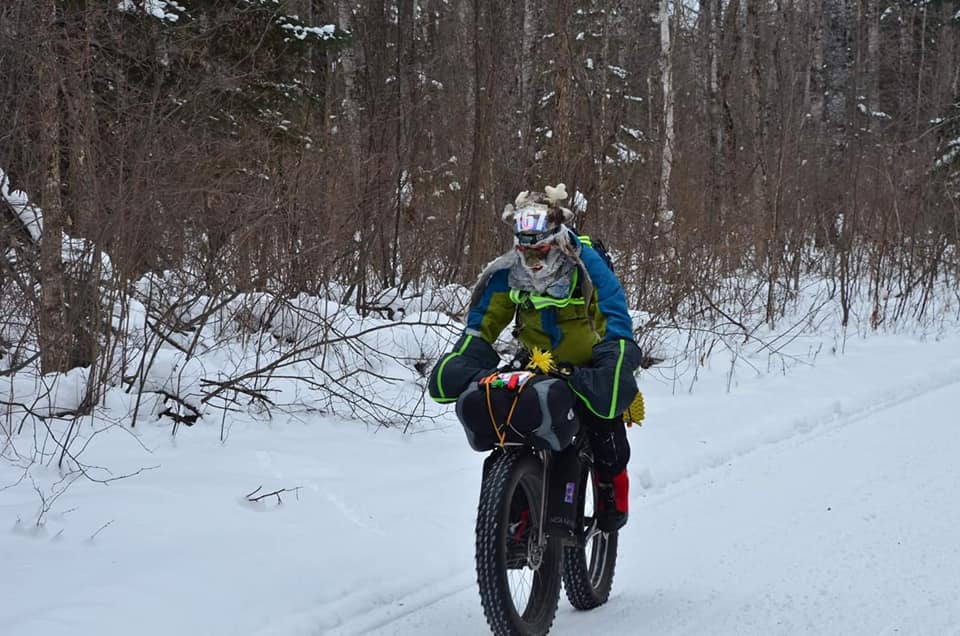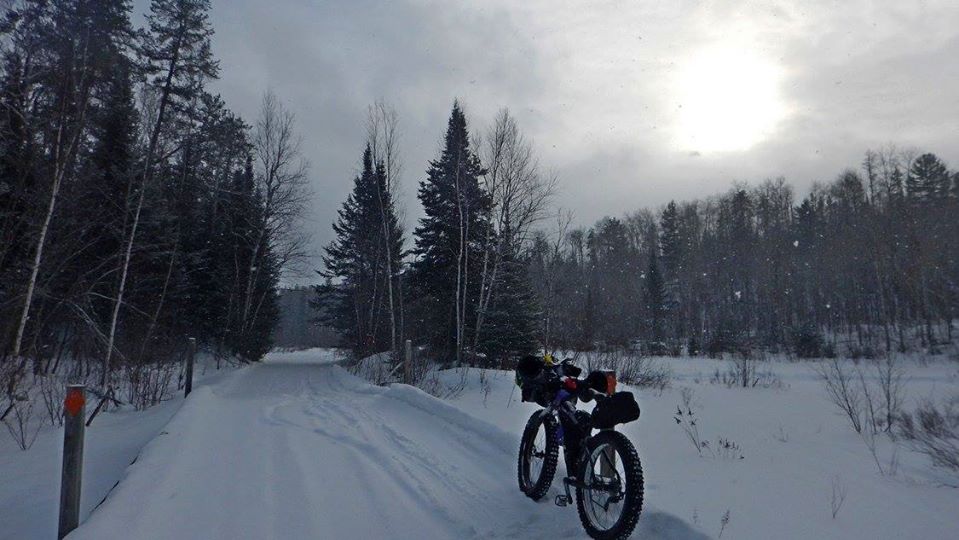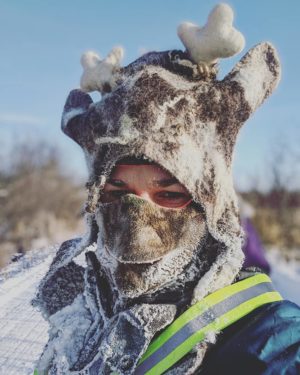The Arrowhead 135, a cycling, running, and skiing race, has been taking place for 16 years in the deep north woods of Minnesota. The perfect test of endurance, temperature limits, and strategy. I had the opportunity to interview Sveta Vold. A Minnesotan, originally hailing from Belarus, she’s a speed demon, loves the winter, and is a 4-time finisher of the Arrowhead 135. She completed one Arrowhead 135 just seven weeks after the birth of her youngest daughter. She pumped during the race to feed her kiddo. (You know, no big deal.) Read on to learn more about this super mom and endurance racer.
The Race
It isn’t just any 135-mile race; it happens in the middle of winter. You might have already guessed this, but northern Minnesota is not very forgiving in the depth of winter. Last year’s race had a temperature of a whopping -40 F (not including windchill). To qualify for this race, you must have completed another ride that is at least 200 miles or a 100-mile off-road race (preferably in winter). There are three checkpoints during the race, and you can be pulled from the competition if you don’t make cut-off times. There are many gear requirements to enter the Arrowhead 135, including arriving with a minimum amount of reserve gear and supplies remaining at finish.
Preparation Skills

The Interview
Before we get into the details of the race, you organize a group called Night Water Butterfly. For this group, you cut a hole in a lake to swim weekly. What was the inspiration behind the group?
This is part of the Russian-speaking community. People do this once per year, for religious purposes, on January 18th. That’s when I tried it for the first time. There’s also a group of people, like me, that do it to improve their immune systems. Since I started to do it regularly, I’m healthy and happy. It gives me adrenaline, especially during the winter, when it’s gray, and you can be depressed. It keeps me positive, like in the summer.
I share this activity because I always try and share the best parts of my life: biking, swimming, adventure. It makes me happy to have people join me. When I started nine years ago, I had 1 or 2 people joining me, but now we have 15-20 people every Sunday. Sometimes, I go with people during the week who couldn’t make it on Sunday. I studied more about it in terms of health, and now I can stay in for 35 minutes. But it isn’t for everyone and some people who have heart conditions or things like that can’t do it. I make sure to review all of that with people who haven’t done it before.
Do you think it helps with winter cycling?
I think it helps me a lot. I’m very good at winter races because I know that if it’s colder outside, there’s a better chance I will be at the top as not everyone can manage cold weather. I’m not a super-fast rider, but I’m tough enough to move when it’s very cold. It also has helped me with my health; I don’t get as many colds.
What made you decide to take on the Arrowhead 135? How do you train for it? How many times have you done the race?
This year will be my 7th time doing the race. I finished four times, two of them unsupported (without breaking at checkpoints). I DNF’d two times. When I moved here in 2011, I didn’t know what fat bikes were. I learned about it, and one of my friends who rode endurance rides with me told me I should do the Tuscobia Winter Ultra. I did a lot of winter riding in Belarus, but on gravel or forest roads. We didn’t have fat bikes. I would do multiple days riding in the winter, so I wasn’t new to that. It sounded cool.
Someone was selling a fat bike for a reasonable price on Facebook, and I bought it. I was the only female who entered. My bike was heavy. I packed for a real adventure; I brought a tent, sleeping pad, medical supplies. I thought it was like bikepacking, and you needed everything with you. I remember being at the start and everyone looking at me, probably thinking I wasn’t going to finish. I did.
Everyone told me I should attempt Arrowhead. I registered. It was -30 F that year. I didn’t finish due to a mechanical issue. The next year, I tried again and placed 2nd. Just because you finish one year does not mean you will complete it the next.
How do you go about training for the Arrowhead 135? Last weekend you did the St. Croix 40-mile race, what is your process?
I’m a busy person, and races are not cheap. I used to do lots to keep in shape, but now I do fewer. It can be $100-$200 per race. I have a family and other priorities. I race to have answers for myself; am I still in good shape? It’s cool to compete as a busy mom and someone who doesn’t have a coach or fancy studio to train. I ride every day or every second day, short or long distances.
Registering for the Arrowhead makes one feel they have to go outside and move, no matter the weather. The colder it is, the better the chance to get proper training. Especially since during the rest of the year, you forget how -30 feels. I always go to Arrowhead with three bags of clothes. The day before, according to the weather, I choose what clothes to wear. For me, as a mom who doesn’t train, it’s cool to know you can be a mom and do other stuff in your life and still be in good shape.
As someone who has completed this race many times, you’ve gained a lot of knowledge through experience. What is the single most useful piece of equipment or tip for this race that you’d recommend to newbies?
We live in a time when marketing can be a little annoying and make you feel like you have to buy things. I started with very cheap stuff from Goodwill as I didn’t have anything. Of course, for cyclists, it’s very important to keep your feet warm. You can play with any type of clothing, but if you don’t have warm boots, that can stop you.
Compared to runners, our feet stay in the same position, so we don’t enough blood coming to our toes. You can buy work or mountain boots; just make sure they are 2-3 sizes bigger than usual, so you can comfortably fit 2-3 pairs of socks or hand warmers. You don’t want them to be tight, or you have a bigger chance of getting frostbite. For me, this is the most important.
You can play with clothes, but make sure they are breathable for sweat. Bring extra socks and gloves in case they get wet. The endurance community is great, and they are always ready to help. You can ask other endurance racers who are usually willing to share their equipment.

Do you/did you have fears about riding this race? How has that changed with every passing year?
Yes, the first year, I kind of did. I remember, at one point, I saw wolf tracks, and it made me a little nervous because I couldn’t see anyone behind or in front of me, even though I knew they were there. But when wolf tracks jump on the trail where you are riding, it makes you kind of nervous. I didn’t see a real wolf, but I didn’t want to stop and eat my food. But the more races I do, I know that I will see more animals in the city than I do out in the wild.
I carry a knife with me when I go on long solo rides, even though I may not be able to react quick enough to use it. I now have a spot tracker so my husband can see where I am. I’m more scared of humans than anything, like when people stop you and ask where you are going – especially in isolated areas. It’s nice in winter when you have to wear more clothing; it’s harder for people to determine your gender. During the Arrowhead 135, I know someone is in front of me and behind me. If I have a bike malfunction, I can always bivy till another rider comes by and can send a snowmobile.
In your opinion, what is the most challenging part of the Arrowhead 135?
The mind. It’s a pretty long distance for winter. The trail is not always the best condition, and there is lots of elevation. After each checkpoint, it gets harder. If you make it to the third checkpoint, it’s in the middle of nowhere, and it’s more challenging to drop from there. Every time I race, I always tell myself I never will do it again. But then, maybe you don’t finish, and you have to come back to finish. Or you finish and wonder if it could be more challenging, like colder, the next year. You come back; it’s like a game.
Last year’s temps were -55F with windchill, what’s your secret cold-weather clothing weapon?
It is very individual for bodies. I have gotten frostbite in the past on several parts of my body. Now I’m more susceptible to getting cold, and I have to manage this more. I don’t like masks that much, so I don’t wear one. I prefer not to cover my nose fully. I always wear a down skirt which keeps my butt warm. At the start, someone once asked, “Aren’t you over-dressed?” And I said, “No, I know my body, and it’s perfect for me.” For some people, maybe they can wear a tiny jacket, but for me, I need warm clothes. As soon as temperatures in Minneapolis get cold, I hop on my bike for a 1-2 hour ride.
Outside of the riding, there are lots of gear and food/water reserve requirements when finishing the race. Did you have any methods for ensuring you had the appropriate amount of reserves when you finished?
Most people buy a jar of peanut butter. It’s small, but enough calories for the reserve. If you have an emergency, you can eat it. I play with gear a lot. One year I brought a gas stove. Now I use a tablet stove. Gas usually freezes, and I experimented with the tablet and found it works just as well and takes up less space.
I don’t take a blow-up sleeping pad with me because when you are tired, you don’t have energy to blow it up. Now I bring a Thermarest pad with me. Also, with headlamps, I don’t bring rechargeable lights with me and always bring many batteries as they die quicker in the cold.
Do you use a dynamo hub?
No, I’d like one, but it’s expensive, and I haven’t been able to get one yet.
You said you did the Tuscobia Ultra in Northern Wisconsin, is that the race you used as your qualifying race?
Yes, I did the Tuscobia Winter Ultra and then the Arrowhead 135. Tuscobia is along railroad tracks. It’s good mind training because it’s a long distance but straight. It lets you know if you can bike the distance. I’ve also ridden the Actif Epica. It’s a more urban race, which I like because you can see different things and see how people live. It’s a faster race because you are on gravel and not double track. You see more communities and how people live, and at one point, you ride along the Canadian-US border, which is neat. I like to see a lot of scenery.

You’re a mom, have a partner, and also work part-time as a firefighter. What has been the most challenging part of balancing training for endurance races and daily living?
This is the hardest part because I’m a perfectionist. I want to be the perfect mom, wife, worker, friend. I do lots of volunteer work, like teaching Russian school every Saturday. I don’t have a full day to go riding every Saturday for training. And Sunday I have my swimming group. Right now, my youngest daughter is in pre-school twice a week. I use those days for more distance training, like 40 miles. But you need one day per week for a distance ride which I haven’t been able to do the last three years. Family is my priority. Right now, when I go to a race, I feel upset. I think, “Gosh, I’m not good.” But it’s still possible.
I biked past you in the Day Across Minnesota 2019 race. We chatted briefly. I knew something was wrong if I was passing you; your reputation precedes you. Your electronic shifting had malfunctioned and was stuck. Will you use that in an endurance race again?
Yes, I just wasn’t familiar with how to fix it. It’s a really cool mechanism, but you have to know how it works. It disconnected and I didn’t know how to re-connect it. I need to learn how.
Non-Cold Climate Folks Wonder
I asked a few of my friends who don’t live in cold-weather climates what they would be curious about. They had many questions, and think we are all crazy (we are, but just the right amount). First up, how do you keep your water from freezing?
I use a thermos with extra insulation and hot water. I also use a regular cycling bottle, which I put in an insulated cover, and under my jacket next to my body. I don’t use the cycling top, but a conventional bottle top. I put it upside down since water freezes from the top first. This way, it’s the bottom that freezes first. When I have half a bottle, I add snow inside. It’s probably not very healthy, but I’ve never had a problem. One year I tried a Camelback underneath my jacket, but it froze in the first leg.
How do you deal with repairs in that type of cold?
It’s hard. That’s why I always carry extra mittens even though I use bar mitts. You have to do it slowly. It’s possible. Remember not to panic and take your time. Even if it takes an hour, you have plenty of time to finish. Don’t let your hands get cold to where they have pain. Do some work, put your gloves on, then do some more, and repeat.
A big thanks to Sveta Vold for taking time out of her busy schedule to chat with me. Best of luck on your race, Sveta!

